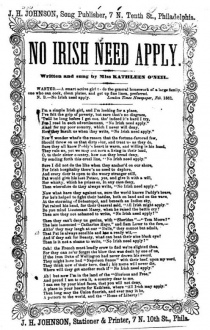From The Peopling of New York City
Irish immigrants had a rough start in New York City, not only trapped in the same poverty as in Ireland, but also derided by their neighbors, fellow European immigrants and native New Yorkers.
They were popular victims of stereotyping, perceived as being boss-controlled, evidenced by Tammany Hall, aggressive and hostile, illegal voters, given to heavy alcoholism and connected with criminal street gangs. What didn’t help this image was that most of the arrests made in the late 19th century were of Irish origin, especially for disorderly conduct.[1]
Regardless, the Irish immigrants never underwent the kind of discrimination as that against Africa-Americans and Asians, who were not allowed to become citizens or even enter the United States.[2]
As a result, they were able to assimilate much more fluidly. They took advantage of their Catholic religion to take over the American Catholic Church to create a parochial school system for their children.[3] They also went after political opportunities that they never had in Ireland. In time, the Irish steadily moved upwards in American society.
What’s truly amazing is that they were one of the first ethnic groups to do so without sacrificing their religious beliefs or cultural heritage. They became Americans their own way and helped to demarcate a distinctive cultural identity that would soon become the example followed by many other immigrant ethnic groups.
By the early 20th century, the Irish had successfully assimilated, its culmination for Irish Catholics when in 1960, President John F. Kennedy was elected.
- Return to Assimilation
- Return to Irish
